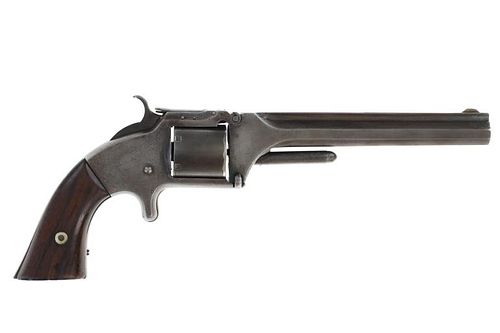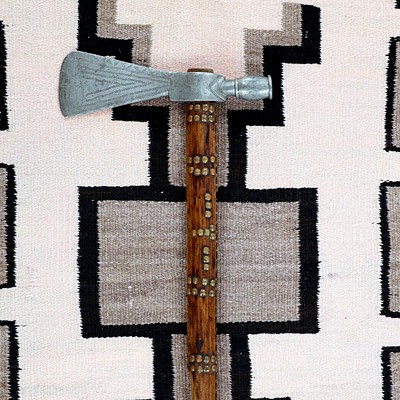George A. Custer's own S&W No. 2 Army Revolver
Two ways to bid:
- Leave a max absentee bid and the platform will bid on your behalf up to your maximum bid during the live auction.
- Bid live during the auction and your bids will be submitted real-time to the auctioneer.
Bid Increments
| Price | Bid Increment |
|---|---|
| $50 | $10 |
| $100 | $25 |
| $500 | $50 |
| $1,000 | $100 |
| $2,000 | $250 |
| $5,000 | $500 |
| $10,000 | $1,000 |
| $30,000 | $2,500 |
| $50,000 | $5,000 |
| $100,000 | $10,000 |
About Auction
Sep 23, 2023
Join us for this timeless treasure trove of Western History items. From George Armstrong Custer's own S&W and Remington Buffalo Rifle, to historic tomahawks, Navajo rugs, Navajo jewelry and many more pieces from the Frontier and Early American history. North American Auction Company tucker@naabid.com
- Lot Description
This is a fine, historic Smith and Wesson Model 2 Army Tip-Up Revolver owned personally by George Armstrong Custer from the Dr. Lawrence A. Frost of Monroe, Michigan Custer Collection, marked, “GAC” by Custer and accompanied by a signed document from Wendell Grangaard from The Guns of History, Inc. Sioux Falls, South Dakota. The firearm was examined by Wendell Grangaard, author and historian on Custer, the Battle of the Little Bighorn as well as the Togia language. Wendell noted the firearm being marked as such: On the left grip carved GAC (George Armstrong Custer) illustration 1,; On the bottom of the frame JAE (Jubal Anderson Early) and GAC (George Armstrong Custer) illustration 2; On the back of the frame JAE (Jubal Anderson Early) illustration 3; On the inside of the left grip GAC (George Armstrong Custer) illustration 4. The paperwork also includes the iconic photograph of General George Armstrong Custer and his wife “Libby” Elizabeth Custer in their temporary quarters at Fort Lincoln, Dakota Territory circa 1874 showing the entire photograph with the pistol rack on the right side. Dr. Lawrence A. Frost noted this revolver as being the last pistol on the right-hand side. According to the historic research this firearm, marked with General Jubal Anderson Early of the Confederacy’s initials, (Tom Custer wrote letters to his sister-in-law Elizabeth “Libby” Custer) this firearm was captured on March 2, 1865, by Tom Custer led by George Armstrong Custer and was in General Jubal Anderson Early’s personal war headquarters’ wagon. They recovered Early’s map books, his orders for the Spring offensive, his guns which included a Spencer sporting rifle 56-46 serial number 61391, a Smith & Wesson Model No. 2 Army Tip-up in 32 long RF serial number 34528 (this firearm), a 12 GA Lefeavor shotgun as well as Early’s personal chess set, shaving mug and razor, a small collection of pipes, a good supply of chewing tobacco, his uniforms, clothes and many sets of boots and hats. Custer gave Tom Early’s personal records; he sent the chess set to his wife Elizabeth. On March 28, 1865, George sent a letter to his wife from Petersburg, Virginia: “I am sending by Mr. Stires a black dress pattern, captured with other dry goods in one of Gen’ Early’s wagons. All desire you to have it. I think it will make a very nice dress.” In Lacrosse, Wisconsin in 1973 Wendell Grangaard was with Dr. Lawrence Frost and was shown this Smith & Wesson No. 2 Army serial number 34528 (at the time the right grip broke and was replaced with a grip bearing the serial number 37774). Lawrence noted the pistol has been at the bottom of a leather travel trunk that belonged to Elizabeth Custer. After the Battle of the Little Bighorn, Elizabeth Custer packed up and left Fort Lincoln and moved back to Monroe, Michigan, moving to the farm George had bought from Nevin Custer back in 1871. She put all of George’s possessions in the special barn Nevin called “The Armory”. Libby sold the farm and moved to New York leaving behind most of Custer’s belongings. Lawrence bought the contents. It is documented by Heritage Auction that Dr. Lawrence A. Frost of Monroe, Michigan, had the most extensive private collection of Custer artifacts and relics ever assembled, such as the Spencer Model 1865 serial number 3658 that Heritage sold in December 2012 for $179,250 (shown w/ bp). Dr. Lawrence Frost started collecting in the 1930’s collecting mostly directly from the Nevin Custer’s family, the only direct relatives of George A. Custer. Frost’s neighbors included Col. Brice Custer who, along with Col. Charles A. Custer who sold a notable bulldog to Frost in 1956, he also purchased the Custer guidon made by Libby Custer which sold at auction for over $900,000. The sale includes the signed provenance, several copies of Custer images, several of the denoted illustrations showing the faint marks, a Flayderman’s Guide print-out showing a write up of this model of gun as well as noting Custer as being documented to use one, and the Fort Lincoln image showing this firearm in the corner. The pistol hammer clicks back and holds into place and correctly rotating the cylinder, the spur trigger releases the hammer, appearing the function as well as the barrel releases tipping or swinging up allowing the cylinder to be completely removed quickly for quicker loading. Top of the gun is marked “Smith & Wesson Springfield, MASS.” The JAE and GAC marks are very faint, with the documentation showing written mark ups to better identify. From the Dr. Lawrence A. Frost Monroe, Michigan collection, the most notable Custer collection to ever exist comes with signed paperwork from Wendell Grangaard. Wendell Grangaard was pivotal in identifying the Custer Battlefield firearm sold many years ago by Holabird, as well as the notable Custer and Little Bighorn artifacts which were written about by Cowboys and Indians Magazine and sold in the Little Bighorn auction in this year. This is an Antique Firearm that does not require an FFL.
- Shipping Info
-
North American Auction Company is proud to announce the opening of our new in-house, full-service shipping department. We have listened to you the customer and will now be handling all outgoing packages in our new shipping department. We are confident this new offering will allow for a smooth transition from auction block to your front step. We have partnered with preferred carriers to ensure a safe, efficient delivery that works best with your schedule. Please allow 14-21 days after complete invoice payment is made to package and ship your purchase. After you are notified of your winning bids from our company and your item invoice is paid in full our new shipping department will contact you. Make sure when signing up with our company that your preferred shipping information is up to date as this information will be used to estimate shipping cost. Once the items have been packaged our team will contact you for shipping payment. Shipping invoices and payment will be completely separately than the items invoice. Please notify the shipping department with any alternate request or instructions at mark@naabid.com or 800-686-4216 ext. 3. For a shipping quote please contact the same information above. PLEASE NOTE a shipping quote price can fluctuate in price. Auction company is not responsible for actual shipping cost being higher than quoted shipping cost. Thank you for trusting North American Auction Co. with your bids and shipping. As our shipping department is brand new please understand that delays can be expected.
-
- Buyer's Premium



 EUR
EUR CAD
CAD AUD
AUD GBP
GBP MXN
MXN HKD
HKD CNY
CNY MYR
MYR SEK
SEK SGD
SGD CHF
CHF THB
THB




























